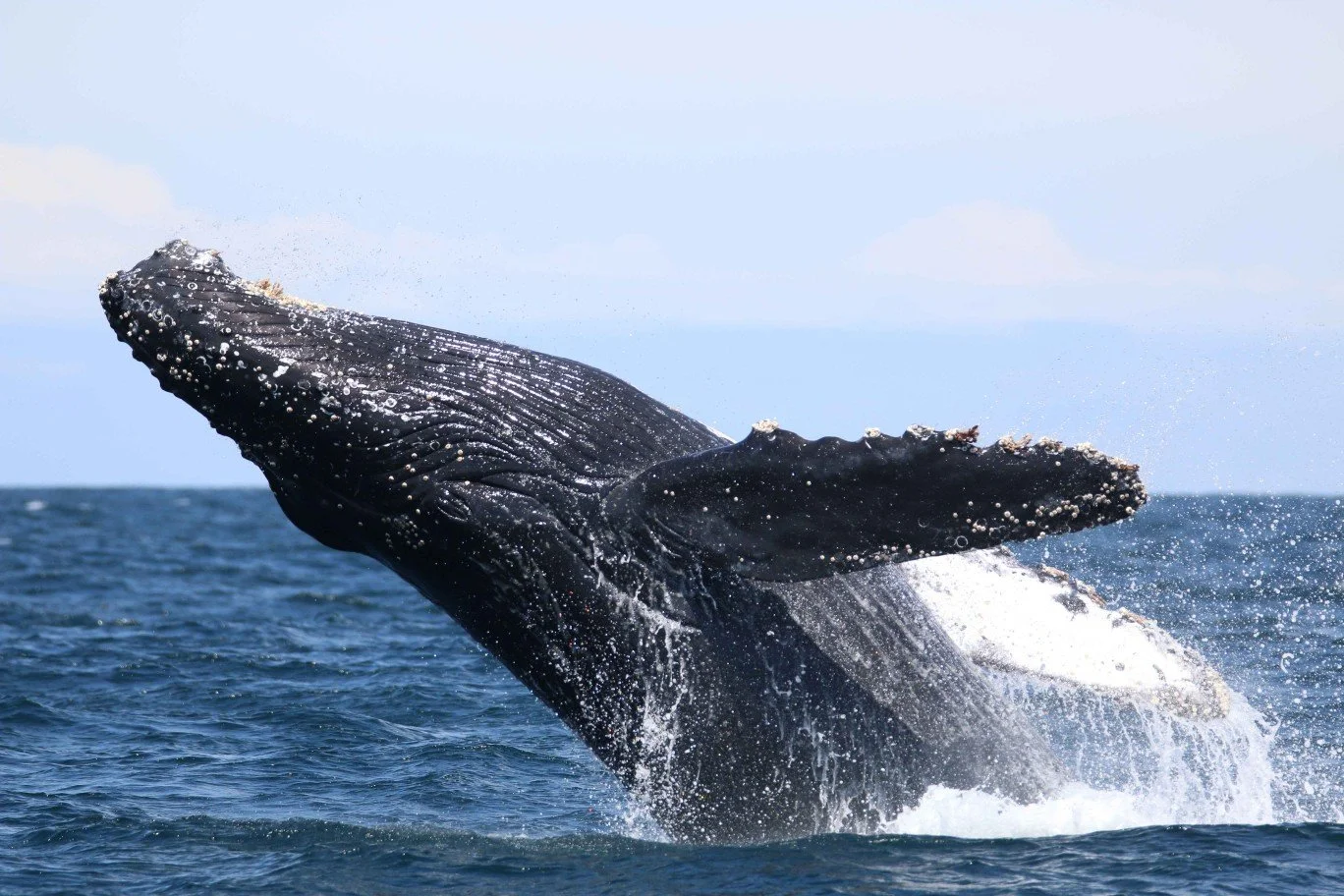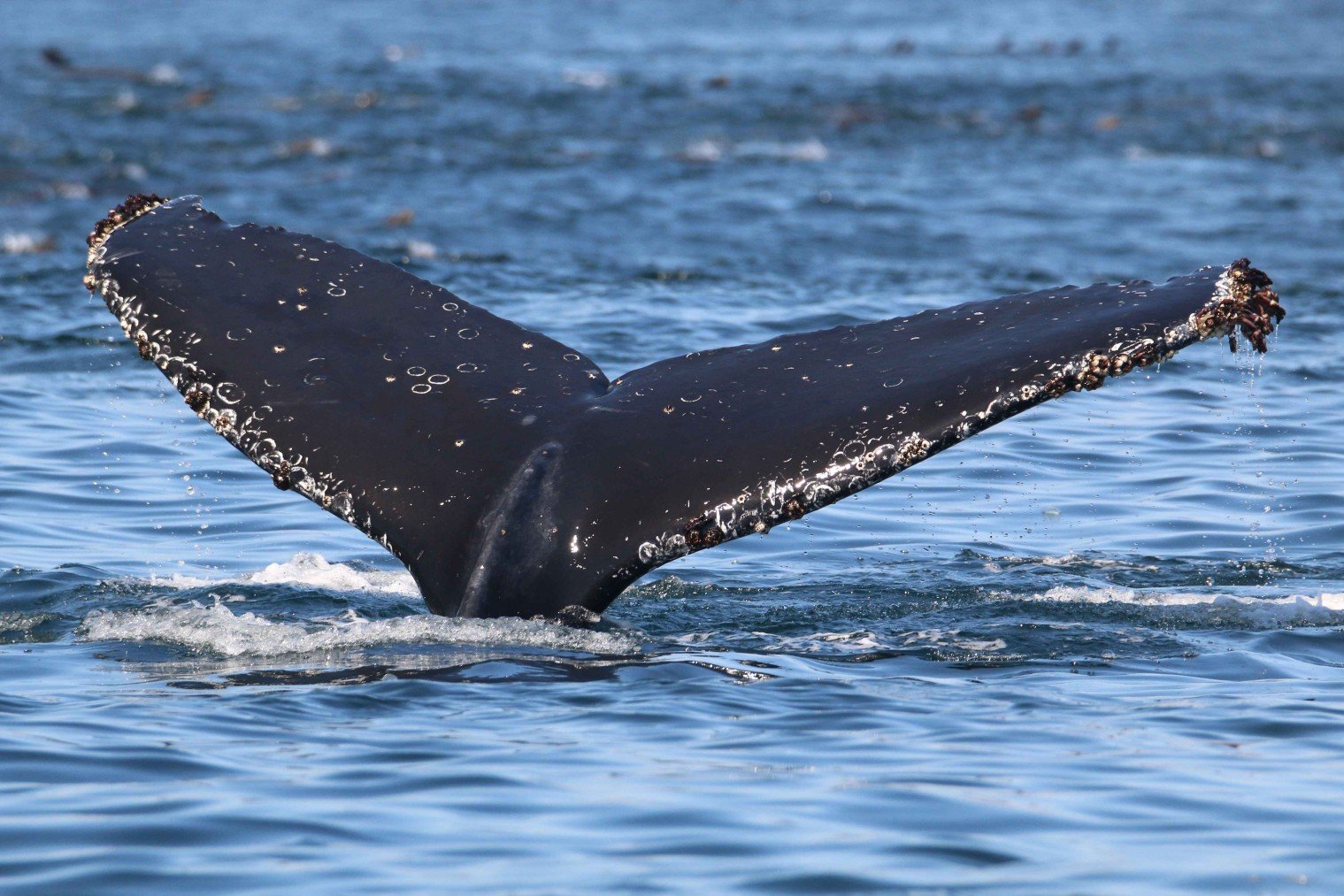Humpback stories: The many tails of Monterey Bay
Each spring, humpback whales return to Monterey Bay, California to feed on krill and anchovies. Thanks to Happywhale – an online database of more than 114,000 humpback whales – we know more about them than ever before. A single photo can reveal who these whales are, where they’ve been and what they’ve encountered.
Sea Wolf II gently rolls with the swell as she steams north from Monterey harbour on a bright but cold April morning. Moss Landing lies to the northeast, while Santa Cruz would be visible further north if it wasn’t for the film of fog across the bay. To the west, 5,000 miles of Pacific Ocean lies between California and Japan. It’s what’s beneath us that matters though. The deep ravine of Monterey Bay’s submarine canyon extends to depths of 3,600 metres, funnelling cold, nutrient-rich waters to the surface. There, the nutrients support an abundance of marine life including krill, anchovies and, ultimately, ocean predators.
As we draw level with Moss Landing – putting us directly over the submarine canyon – the clustered blows of humpback whales grow taller. Humpbacks are just one of the species to capitalise on this bounty. Rafts of California sea lions churn the water, surfacing with raspy breaths. Gulls hang above with orange feet dangling, dropping down to pick up the spoils.
“These whales are probably feeding at depth,” says Dr Cheeseman as we draw closer. Whale watchers clad in warm jackets crane their necks for views of the first whales of the trip. “This is a really special time of year because these whales are just getting back from their migration and are particularly hungry,” he explains. Humpbacks that feed in these waters during spring, summer and autumn, then migrate to warmer waters to breed during the winter months.
On cue, a humpback surfaces off our bow, a powerful exhalation blasting whale breath skywards before it drifts our way. A fug of sun-rotted seaweed envelops us. Another whale surfaces, its knobbly upper jaw gleaming black as it rises above the water. The sea beside them turns a tropical turquoise as their white pectoral fins glow beneath the surface. The two whales each take a couple more breaths before arching their colossal backs as they prepare to dive. “Here we go, maybe we’ll see a fluke,” warns Dr Cheeseman. Cameras are raised as passengers hope for a fluke shot.
“When they lift their tails, the underside of the tail is individually recognisable. And with that photo, we can identify every single whale,” he says, explaining how the Happywhale database works.
Identifying individual animals from their markings isn’t new, marine biologists have been studying humpbacks this way since the 1970s. Studying prints or slides to compare the patterns of black and white pigmentation, scars, and shape of the whales’ flukes was labour intensive and time consuming. “Like a memory game with bigger and bigger sets of cards,” says Dr Cheeseman.
“Over the last 10 years, we have built a system to automate this, to use AI to recognise every individual.” Happywhale uses a modified facial recognition system to extract details from a photo of the whale’s flukes to identify the whale.
One of Happywhale’s strengths is it’s open to all. Anyone can contribute and it’s popular with scientists, tour operators, and whale watchers. “As a result, we’ve identified almost every living humpback whale in the North Pacific,” continues Dr Cheeseman, “which is fun because we get to track them and know their stories, which would be very hard to do without such technology.”
The two whales closest to us sink beneath the surface without showing their flukes. The next individual dives, raising heavily scarred tail flukes. Series of parallel rake marks are thickly etched in white against the black of the whale’s tail – this whale was attacked by killer whales. The rake marks – with the same spacing as killer whales’ peg-like teeth – scar all edges of the tail flukes, top and bottom.
The tip of one fluke is missing, bitten off. This whale, Akiko, was first photographed and reported to Happywhale in 2022 when it was a calf swimming alongside its mother (known as Blingy in Happywhale) in Monterey Bay. Akiko already had these extensive scars. Dr Cheeseman explains that killer whales are the humpback whales’ main predator. “They particularly go for calves,” he tells us.
Killer whales are frequently seen in Monterey Bay, particularly during the spring when humpback whales return from Mexico with their calves and grey whales are passing by with calves in tow. Pods of killer whales traverse the edge of the canyon, reducing their vocalisations to avoid detection. The grey whales travel stealthily too, trying to pass by unnoticed.
Akiko has now been reported 82 times. All but one of these sightings were in Monterey Bay. The other sighting was from 1,100 miles away, close to La Paz, in Baja, Mexico. The vast majority of humpback whales feeding in the waters of California travel to the warmer waters of Mexico and Central America for the winter months, whereas humpbacks that feed in Alaska migrate to Hawaii.
There is very little overlap between these distinct populations.
Within these general movement patterns, different whales show varying degrees of faithfulness – site fidelity – to their feeding area. The next whale surfaces beside the stern of Sea Wolf II prompting shrieks of surprise from passengers. “We call it a mugging when they come so close that we have to turn off our engines,” laughs Dr Cheeseman before adding, “that’s awesome, I will never get tired of that.”
The whale rises again close to our port side, then our starboard side, and is soon identified as whale CRC-19874. CRC-19874 has been seen 32 times since 2021 and only ever within Monterey Bay.
This site fidelity can seem counterproductive at times, particularly as the whales face climate change. Between 2014 and 2016 the largest marine heatwave ever recorded warmed the northeast Pacific Ocean, wreaking havoc on ocean productivity. Krill stocks crashed in California, but humpbacks could still feed on anchovies.
Up in the Gulf of Alaska, though, food stocks collapsed for three consecutive years. Tracking individuals using the Happywhale database showed no whales relocated long distances. “Instead of going to southeast Alaska, they didn’t go to Russia or western Alaska, southern British Columbia or California,” Dr Cheeseman tells us. “Instead, they went back to the same places.”
During that time, about a third of the Hawaii-Alaska population died – some 7,000 whales. “They’re able to switch prey. They’re able to switch feeding techniques, but it would seem to be too high of a cost to go to a region they’re completely unfamiliar with,” Dr Cheeseman explains. “So there’s a resiliency there, but there’s also sensitivity.”
Sea Wolf II, engines running again, slowly trails the feeding activity. Sea lions dive with the whales then reappear before them, pre-warning passengers of the whales’ return. Common murres bob at the surface and pelagic cormorants fly low to the water, long necks outstretched.
Dr Cheeseman’s updates are interspersed with excited shouts. Whales at 10 o’clock! Whale coming up on our starboard side! Passengers duck through the cabin from one side of the vessel to the other, cradling their cameras in chilled hands. Occasionally there’s a cry of “breach!” as a whale launches itself out of the depths, spray corkscrewing outwards as the humpback twists, long pectoral fins lifting as up to 40 tonnes of muscle and blubber goes into free fall. As the boom and blast of whitewater subsides, stunned faces transform into huge grins.
As a whale dives alongside us, Dr Cheeseman points to a deep white scar on its peduncle, just forward of the whale’s tail flukes. “That notch there was an entanglement scar,” he tells us. “It’s one of the major threats to these animals.”
It might be a whale called Check, he thinks, who had been disentangled 10 days earlier.
Check was first found entangled in more than 120 metres of fishing gear in October 2024. Rough seas, fog, and the close proximity of other whales thwarted earlier disentanglement attempts. Underwater photos showed a mass of line and fishing buoys wrapped tightly around Check’s tail stock, cutting into his flesh and adding drag as he swam.
When finally freed, Check swam away with another whale, but scientists were keen to see him again to document his recovery. The results ping back from Happywhale. “It isn’t Check,” reveals Dr Cheeseman, “but a good old friend named Angel Wing.” First photographed in 2005, she’s now been reported to Happywhale 308 times (305 of those sightings from Monterey Bay). Over the years, she’s been seen with four calves, the most recent was photographed in Monterey Bay last summer as they breached side by side.
We’re all absorbed, guessing where the whales might be next when Dr Cheeseman gets more good news. “There’s a whale named Aria who just dived here. She is a local celebrity. She was born in 2022 to a whale who was the best-known whale in Monterey Bay, the best-known whale in California.” That whale was Fran.
Fran was first reported to Happywhale in 2005 and, from 2007, was reported every year, often from California and sometimes from her wintering grounds in Mexico. That is, until she was struck by a ship and killed in California in August 2022. Her body washed up in Half Moon Bay, between Monterey and San Francisco. There, her broad flukes were photographed against the sand, confirming her identity. The Mercury ran the headline, “Beloved humpback whale Fran killed by ship; will her calf survive?”
“The calf would have been maybe nine months old at that point,” Dr Cheeseman tells us. “She was not seen, and I honestly figured the calf was probably dead. It seemed to me that the calf would probably have been hit as well, or – without mom – would not have survived.” Then, in April 2023, Dr Cheeseman received a phone call from a naturalist with Monterey Bay Whale Watch saying, “I think I saw Aria!” Photos confirmed it. “We were so excited,” Dr Cheeseman continues, “and that’s the first time I’ve seen Aria since Fran was killed. So that’s pretty special to me.”
All eyes are on Aria, the calf who defied the odds, as she surfaces again off our port side.
By the time Sea Wolf II is safely back alongside in Monterey harbour and our photos have been uploaded to Happywhale, the number of humpbacks seen that day has risen to 45. With each photograph added to the database, their stories continue. And we learn more.
When a hydrophone that was moored in Monterey Bay detected more singing from humpbacks, data from Happywhale helped unravel the mystery. Yes, there were more whales in the bay – the population has been increasing as it recovers from whaling – but the increase wasn’t enough to justify how much more singing was being detected.
Instead, the increased level of humpback whale song was linked to an increase in the availability of forage fish in the bay. As Dr Cheeseman summarises it, “Happy whales sing more!”
This article can be found here.


